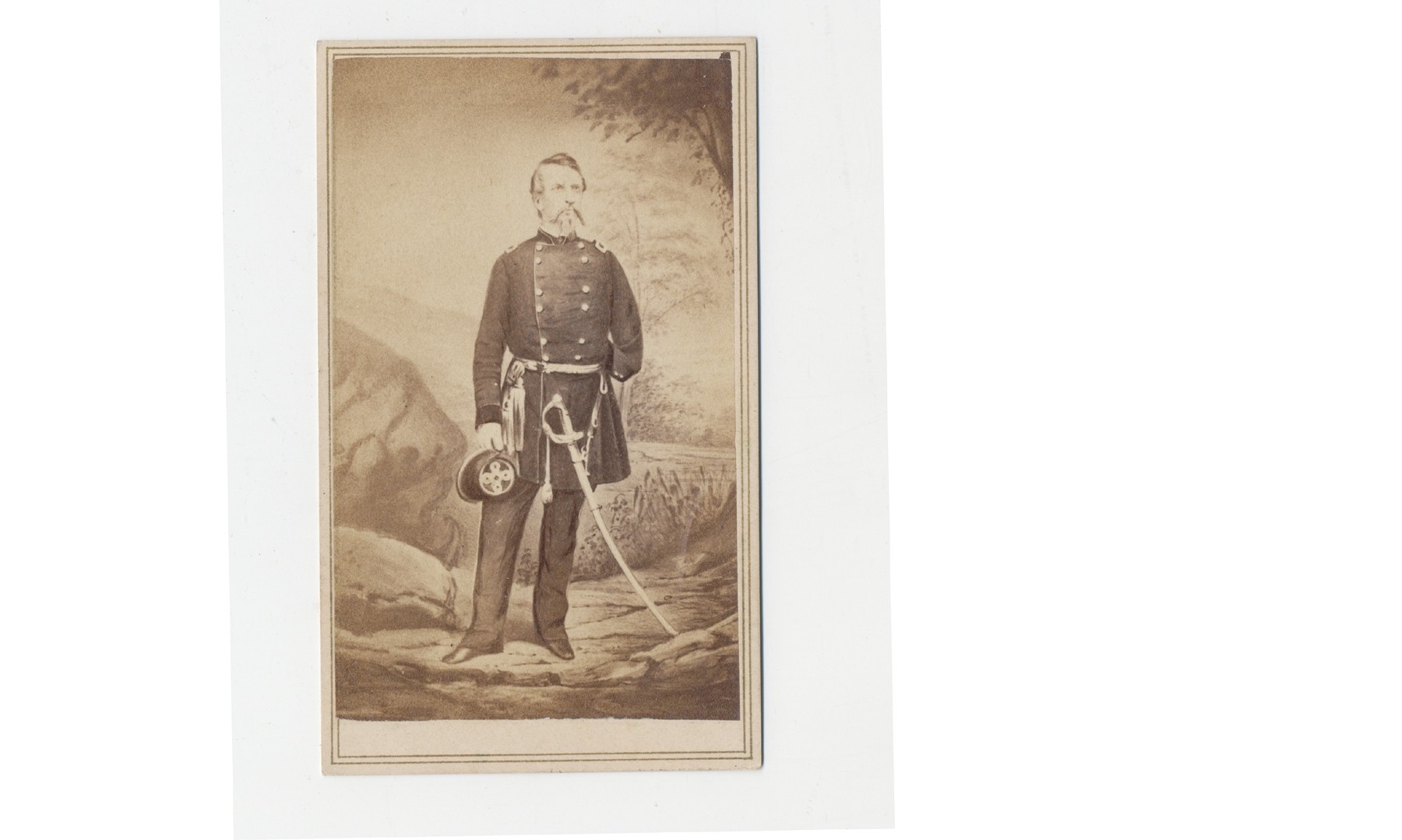site search
online catalog
WARTIME LITHOGRAPH OF MAJOR GENERAL PHIL KEARNY BY BRADY

$125.00 SOLD
Quantity Available: None
Item Code: 259-87
Full standing image of Kearny wearing a dark double-breasted frock coat with shoulder straps and matching dark trousers. He left sleeve is pinned up and in his right hand he holds a kepi with a quatrefoil on the disc. At his waist is a thin belt and sash supporting a Model 1850 Foot Officer’s sword.
Image is clear with good contrast. Top edge has a slight shadow.
Reverse has old pencil inscription “GEN. KEARNY” and a photographer’s back mark for BRADY’S GALLERIES.
Philip Kearny Jr. was born June 1, 1815 in New York City. Although Kearny was quite wealthy as a result of inheriting money from his grandparents, he chose to join the army and was commissioned a second lieutenant in the 1st Dragoons in 1837. Shortly after joining the regiment, Kearny traveled to France where he attended the French Cavalry School in Saumur. He then served in Algiers with the French cavalry in 1840. Returning to the United States, he became the aide-de-camp for Generals Alexander Macomb and Winfield Scott. He served during the Mexican War where he participated in the battles of Contreras and Churubusco. During the battle of Churubusco, he received an injury to his left arm which resulted in its amputation. Kearny continued to serve until the wars end when he resigned from the United States army and moved to France. While there, he served in the Imperial Guard of Napoleon III and fought in the battles of Magenta and Solferino.
When the Civil War began Kearny returned to the United States and was one of the first to be commissioned a brigadier general and was given command of the First New Jersey Brigade. On July 4, 1862, he was promoted to major general and was put in command of a division in General Samuel P. Heintzelman’s III Corps. Kearny was later credited with developing the concept of corps badges, which would go on to be adopted by the entire army. He led his division at the battles of Williamsburg, Fair Oaks, and throughout the Peninsula Campaign. After the battle of 2nd Bull Run, Kearny led the rearguard of the army and engaged Confederate forces at Chantilly. While scouting positions near his lines, he inadvertently rode into the Confederate positions, and was killed while attempting to escape. General Robert E. Lee, who held great respect for General Kearny, forwarded his remains under a flag of truce to Union lines in order to ensure that the general would receive a proper burial.
His body was originally buried in an unmarked vault in Manhattan's Trinity Churchyard until 1912, when an influential member of his old brigade secured his re-burial with full military honors in Arlington National Cemetery. He rests today under a large equestrian monument. [ad]
~~~~~~~~~~~~~~~~~~~~~~~~~~~~~~~~~~~
THIS ITEM, AS WITH ALL OTHER ITEMS AVAILABLE ON OUR WEB SITE,
MAY BE PURCHASED THROUGH OUR LAYAWAY PROGRAM.
FOR OUR POLICIES AND TERMS,
CLICK ON ‘CONTACT US’ AT THE TOP OF ANY PAGE ON THE SITE,
THEN ON ‘LAYAWAY POLICY’.
THANK YOU!
Inquire About WARTIME LITHOGRAPH OF MAJOR GENERAL PHIL KEARNY BY BRADY
For inquiries, please email us at [email protected]
Most Popular
Historical Firearms Stolen From The National Civil War Museum In Harrisburg, Pa »
Theft From Gravesite Of Gen. John Reynolds »
Cavalry Carbine Sling Swivel »
Fine Condition Brass Infantry Bugle Insignia »
featured item
RARE EBERLE 1796 CONTRACT MARKED BAYONET
This rare bayonet is marked by the maker in a sunken cartouche with raised letters on the base of the blade reading “Eberle.” Charles Louis Eberle emigrated to the U.S. from Germany with brothers George A. and Henry J. in 1794, arriving in… (1052-86). Learn More »




